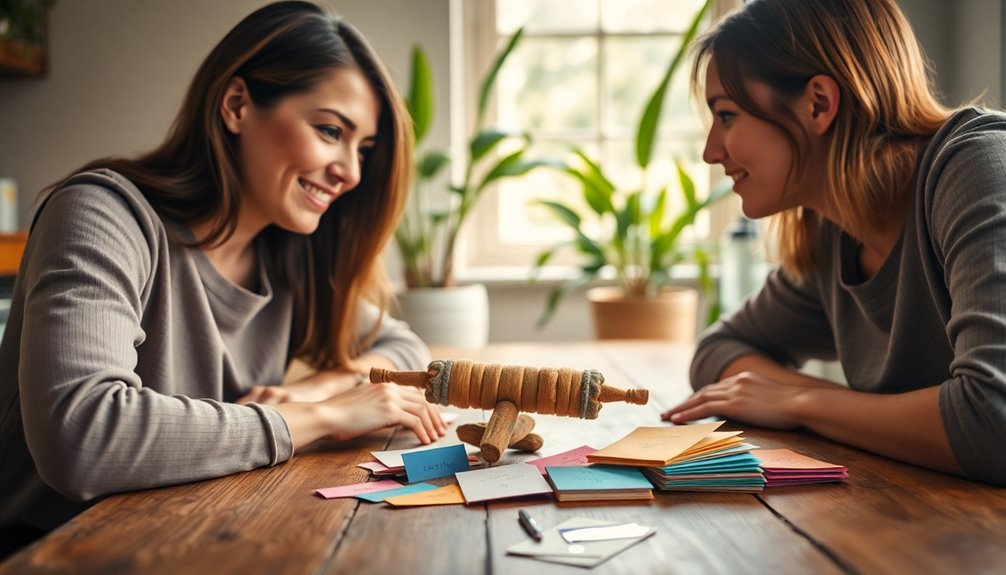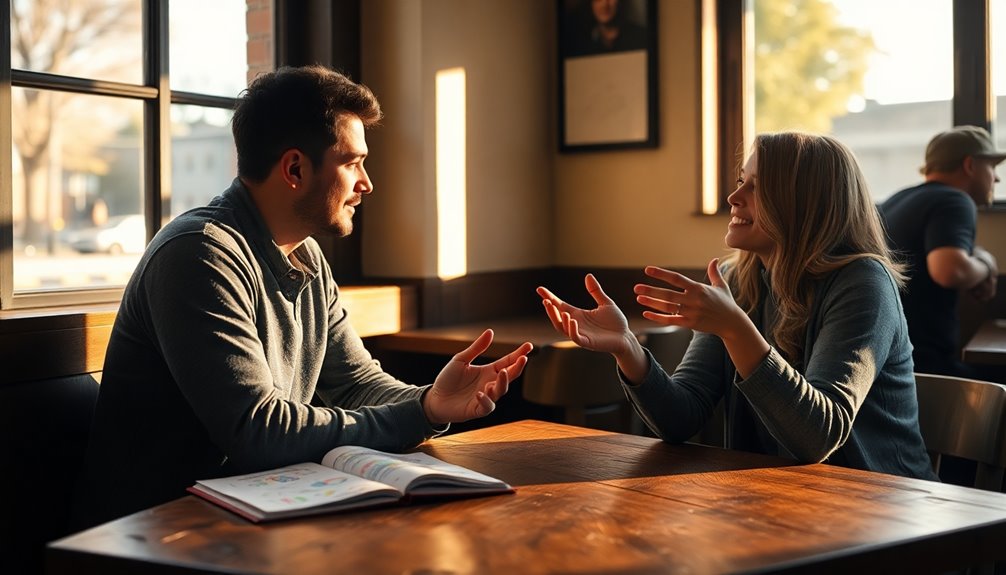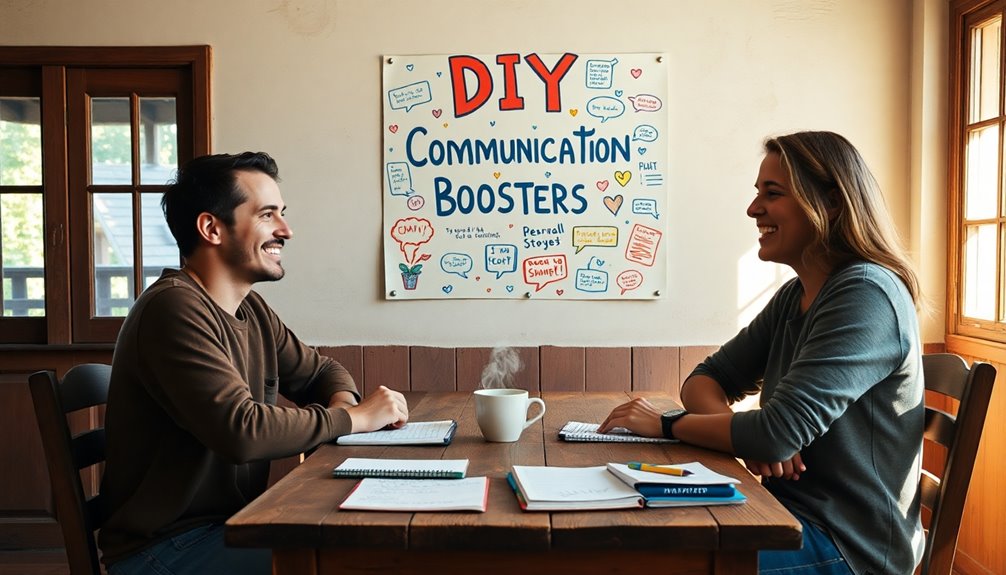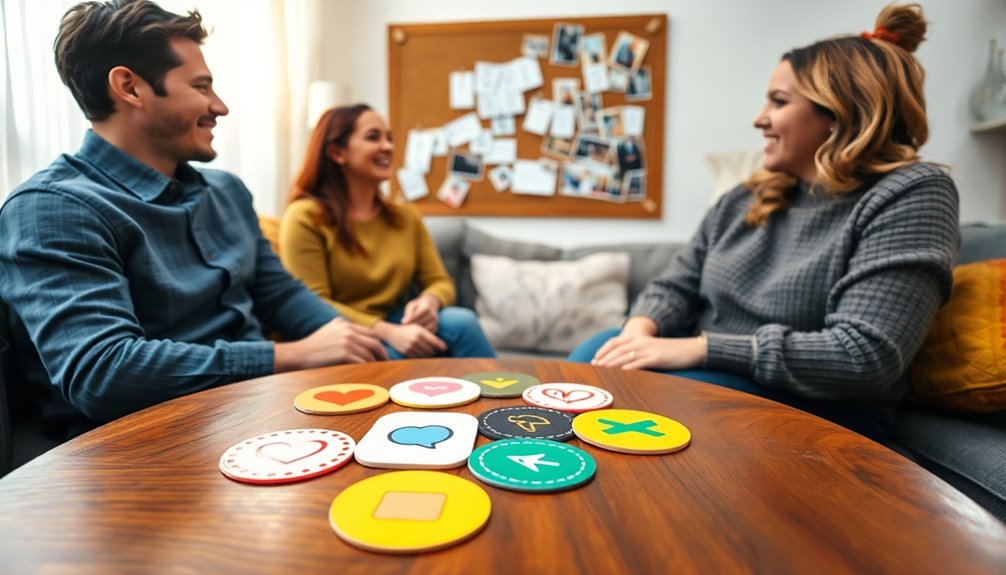To boost your conversations, practice active listening by fully engaging with the speaker. Maintain eye contact and ask open-ended questions to encourage deeper dialogue. Pay attention to nonverbal cues like body language and facial expressions. Share personal stories briefly, focusing on clarity and relatability. Finally, don't hesitate to seek feedback for improvement. By incorporating these tips, you'll enhance your communication skills and build stronger connections. There's so much more to explore on this topic.
Key Takeaways
- Practice active listening by maintaining eye contact, eliminating distractions, and reflecting back what you hear to ensure understanding.
- Use open-ended questions to encourage deeper discussions and invite others to share their thoughts and feelings.
- Be mindful of nonverbal cues, such as body language and facial expressions, to enhance connection and rapport during conversations.
- Tailor your communication style to align with the listener's interests and experiences for more relatable and engaging interactions.
- Seek feedback after conversations to identify areas for improvement and foster self-awareness in your communication skills.
Importance of Active Listening

Active listening is essential for effective communication, as it requires you to fully engage with the speaker. By practicing active listening, you concentrate on understanding and remembering what's being said, which enhances your conversations and relationships.
When you eliminate distractions, maintain eye contact, and use positive body language, you demonstrate attentiveness. This non-verbal communication shows the speaker you value their thoughts, fostering a supportive environment.
Research indicates that those who actively listen are perceived as more empathetic and trustworthy, leading to stronger interpersonal connections. Furthermore, active listening can improve retention of information by up to 70%. Additionally, engaging in online communities can further enhance your conversation skills by providing diverse perspectives and feedback.
The Power of Open-Ended Questions

Open-ended questions can transform your conversations by encouraging deeper discussions and revealing emotions.
When you ask "what" or "how," you invite others to share their insights, fostering genuine connections.
This approach not only enhances understanding but also enriches the overall interaction. Additionally, engaging in open-ended dialogues supports emotional regulation by allowing individuals to express their feelings and thoughts more freely.
Encourage Deeper Conversations
When you aim to spark deeper conversations, asking open-ended questions can be a game changer.
These questions encourage others to share their thoughts and feelings, moving beyond simple "yes" or "no" responses. As an effective communicator, you'll discover that:
- Starting with "what," "how," or "why" prompts more elaborate responses.
- Open-ended inquiries foster a safe space for vulnerability and authenticity.
- Engaging discussions activate pleasure centers in the brain, making conversations enjoyable.
- Demonstrating genuine interest strengthens trust and rapport in both personal and professional relationships.
- Additionally, incorporating techniques from nighttime meditation can enhance your listening skills and presence during conversations.
Explore Emotions and Insights
As you engage in conversations, tapping into the power of open-ended questions can reveal a wealth of emotions and insights.
These questions, starting with "what," "how," or "where," encourage deeper exploration and foster more meaningful communication. By asking open-ended questions, you prompt others to reflect and share their experiences, leading to richer discussions.
Research shows that this approach increases engagement and satisfaction, as it requires more than just a simple yes or no response. You'll uncover underlying motivations and feelings, enhancing empathy and understanding.
Incorporating open-ended questions not only stimulates critical thinking but also demonstrates your genuine interest in the other person's thoughts and emotions, making your conversations more impactful and fulfilling.
Foster Genuine Connections
Many people underestimate the impact of open-ended questions on building genuine connections. By asking questions that start with "what," "how," or "where," you invite richer responses and encourage meaningful interactions.
This approach fosters empathy and understanding, allowing others to share their thoughts and experiences.
Here are some ways to incorporate open-ended questions into your communication habits:
- Encourage sharing: Ask about feelings or experiences to deepen the conversation.
- Build rapport: Show genuine interest in the other person's perspective.
- Create a safe space: Make sure both parties feel valued and heard.
- Enhance engagement: Use these questions to explore thoughts and feelings freely.
Additionally, engaging in open communication can help address emotional detachment that may arise in long-term relationships.
Enhancing Nonverbal Communication

Nonverbal communication plays a huge role in how your message is received, often making up 65 to 93 percent of your impact.
By being aware of your body language and maintaining eye contact, you can create a stronger connection with others.
Let's explore how these elements can enhance your conversations and build trust.
Body Language Awareness
Understanding body language is key to enhancing your communication skills, as it accounts for 65 to 93 percent of the impact you make.
By being aware of nonverbal cues, you can create more meaningful interactions. Here are some tips to improve your body language awareness:
- Maintain open body language, like uncrossed arms and a relaxed posture.
- Use eye contact to build trust and show attentiveness.
- Smile to convey positivity and enhance rapport.
- Practice active listening by nodding and tilting your head to encourage deeper conversation.
Eye Contact Importance
Eye contact serves as a powerful tool in effective communication, instantly conveying confidence and sincerity. When you maintain eye contact, you enhance trust and rapport, making conversations more meaningful. Research shows that appropriate eye contact boosts engagement, demonstrating attentiveness. Aim for eye contact about 50-70% of the time to strike a balance; too little can signal disinterest.
| Aspect | Impact | Tip |
|---|---|---|
| Confidence | Conveys sincerity | Maintain steady gaze |
| Engagement | Increases attentiveness | Use appropriate eye contact |
| Non-verbal Cues | Accounts for 65-93% of communication | Combine with body language |
Building Empathy in Conversations

When you engage in a conversation, actively listening without interrupting can create an environment where the speaker feels valued and understood.
This practice is essential for building empathy, as it fosters trust and deeper connections.
Here are some effective strategies to enhance your empathetic communication:
- Use open-ended questions to encourage deeper dialogue.
- Pay attention to non-verbal cues, like eye contact and nodding, to show support.
- Acknowledge your limitations by expressing vulnerability, which invites honest exchanges.
- Reflect back what you hear to guarantee understanding and validation.
Additionally, establishing healthy boundaries can enhance the quality of your conversations by ensuring that both parties feel respected and safe to express themselves.
Practicing Presence and Engagement

Practicing presence and engagement in conversations not only enhances your ability to recall details but also deepens your understanding of the speaker's message. When you focus on the conversation, you're more likely to remember key points.
Use eye contact and non-verbal cues to show your engagement; this builds rapport and encourages more meaningful exchanges. Being fully present fosters empathy, allowing you to connect emotionally and supportively.
Avoid multitasking, as it disrupts cognitive processing and diminishes the quality of your interactions. Embrace moments of silence; they provide valuable time for reflection, enhancing clarity.
Sharing Personal Stories Effectively

Sharing personal stories can be a powerful way to connect with others, as they often evoke shared emotions and experiences.
To share your stories effectively, consider these tips:
- Be concise: Keep your anecdotes relevant; aim for 20 seconds to maintain interest.
- Tailor your content: Align your stories with the listener's interests for greater relatability.
- Use storytelling techniques: Incorporate vivid descriptions and emotional triggers to captivate your audience.
- Encourage two-way dialogue: Balance sharing with active listening, inviting others to share their experiences.
Additionally, sharing personal stories can foster strong communication skills that enhance relationships and create deeper connections.
Seeking Feedback for Continuous Improvement

How can seeking feedback transform your communication skills? Actively asking for feedback from peers and friends helps you uncover blind spots and improve your communication.
It fosters self-awareness and reveals areas for growth in your conversational skills. Regularly inviting constructive criticism allows you to adapt your techniques, making your interactions more effective.
After conversations, engaging in feedback sessions helps you pinpoint strengths and weaknesses, promoting continuous improvement. Using tools like surveys or informal check-ins can gather diverse perspectives on your style, supporting targeted enhancements.
By embracing a mindset open to feedback, you not only boost personal development but also strengthen relationships, demonstrating your commitment to effective communication. Moreover, incorporating insights from music therapy for autism can enhance your ability to connect and communicate with a wider range of individuals.
Frequently Asked Questions
How Can I Make Myself More Conversational?
To make yourself more conversational, start by practicing active listening. Focus fully on the speaker, showing you value their words.
Try asking open-ended questions to dive deeper into topics. Pay attention to your body language; maintain eye contact to show engagement.
Use the "Yes, And" technique to build on ideas collaboratively.
Ultimately, seek feedback from friends on your communication style to identify areas for improvement and enhance your interactions.
How Can I Improve My Conversational Skills?
"Practice makes perfect," so to improve your conversational skills, focus on active listening. Fully engage with your speaker and ask open-ended questions to foster dialogue.
Be mindful of your body language—maintain eye contact and an open posture. Avoid redirecting conversations back to yourself; instead, support the other person's narrative.
Finally, seek feedback from friends to identify areas for growth and refine your approach. With time, you'll notice significant improvements in your communication.
How Can I Make My Conversation Better?
To make your conversation better, start by focusing fully on the speaker. Engage in active listening and resist the urge to plan your response while they talk.
Ask open-ended questions to dive deeper into their thoughts and feelings. Pay attention to your body language and maintain eye contact, as this shows you care.
Finally, embrace moments of silence to reflect, enhancing clarity and demonstrating your attentiveness to what the other person shares.
How Do You Make a Conversation Flow Better?
To make a conversation flow better, think of it like jazz—improvise and build on what's already been said.
Ask open-ended questions to invite deeper insights, and practice active listening by giving your full attention.
Use the "Yes, And" technique to keep the energy alive, showing you value their input.
Pay attention to your body language, and share personal stories when it feels right, creating a more connected and enjoyable exchange.
Conclusion
So, there you have it! With these DIY communication boosters, you'll be the next conversation guru—maybe even the Picasso of chit-chat! Just remember, while you're busy perfecting your active listening and crafting open-ended questions, don't forget to occasionally nod and smile. After all, no one wants to be the person at the party who can't tell a story without putting everyone to sleep. Go ahead, transform your talks and watch as the world hangs on your every word!









